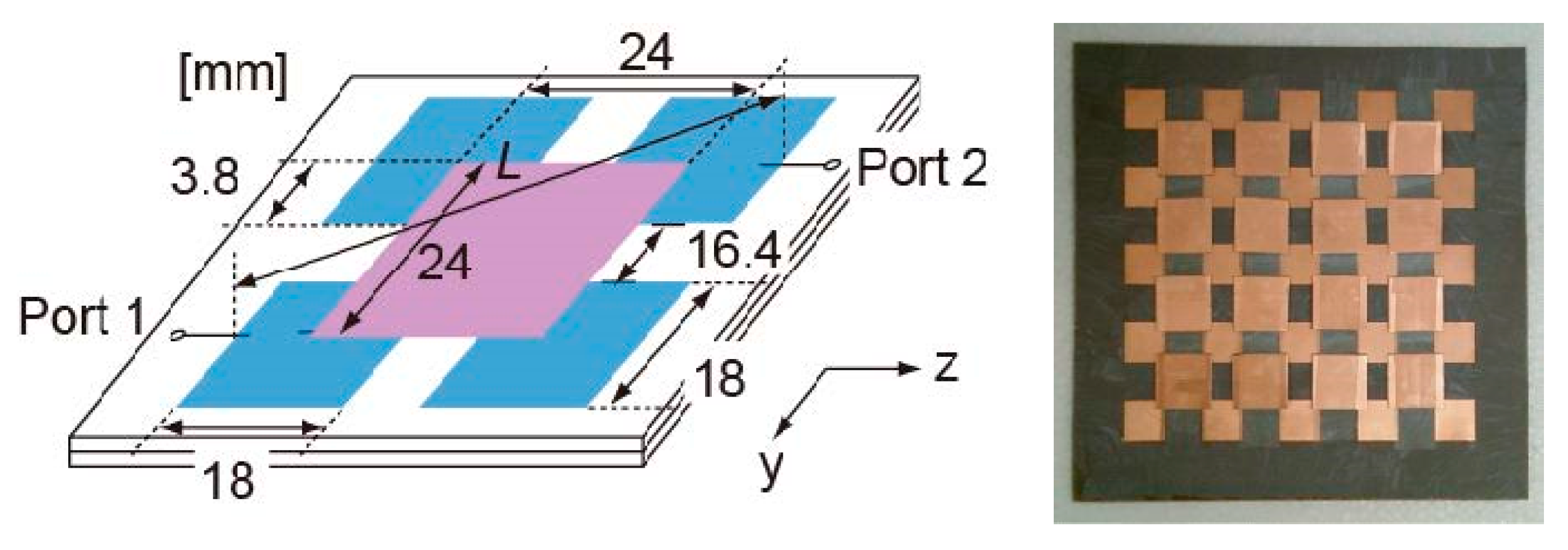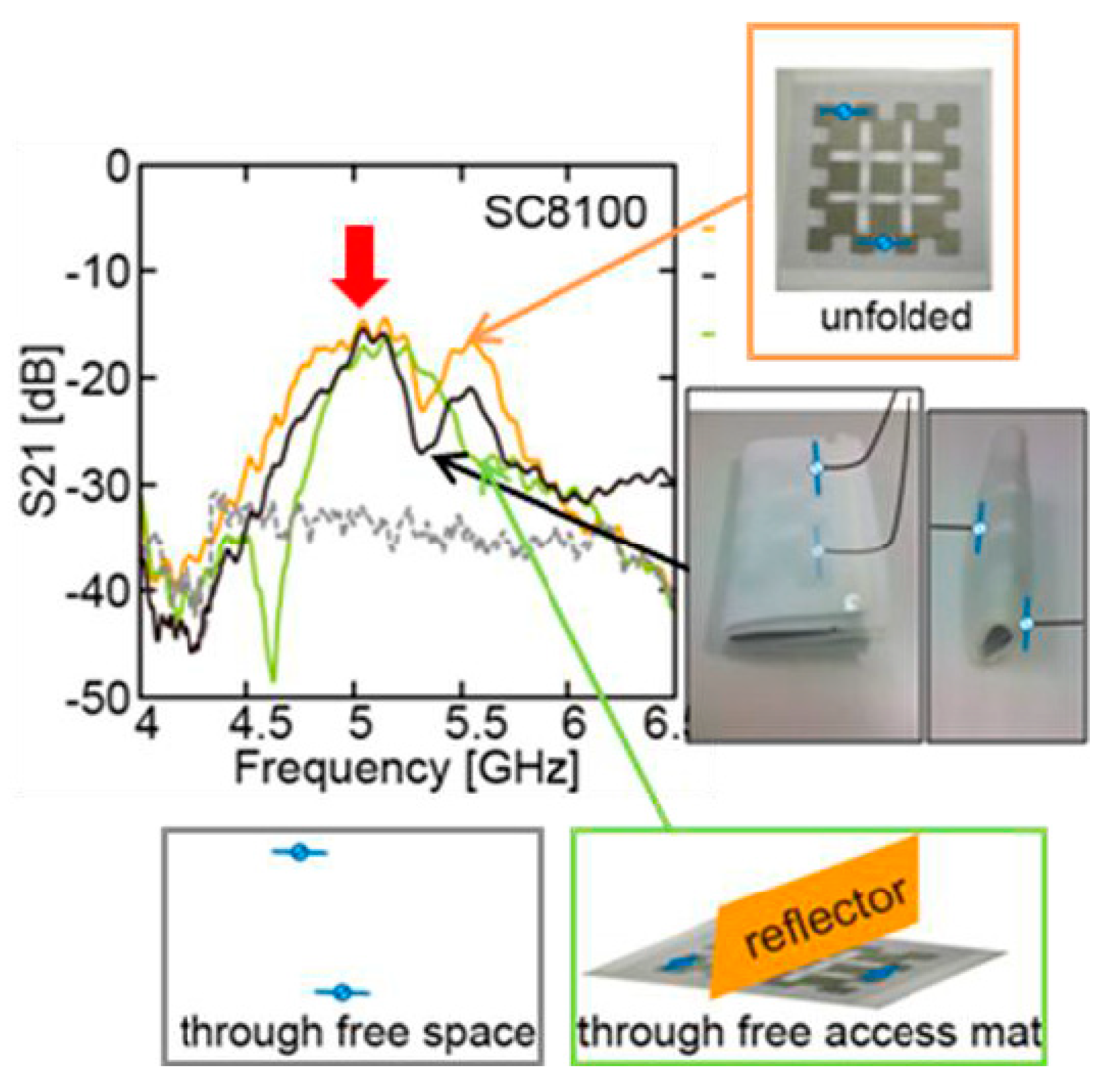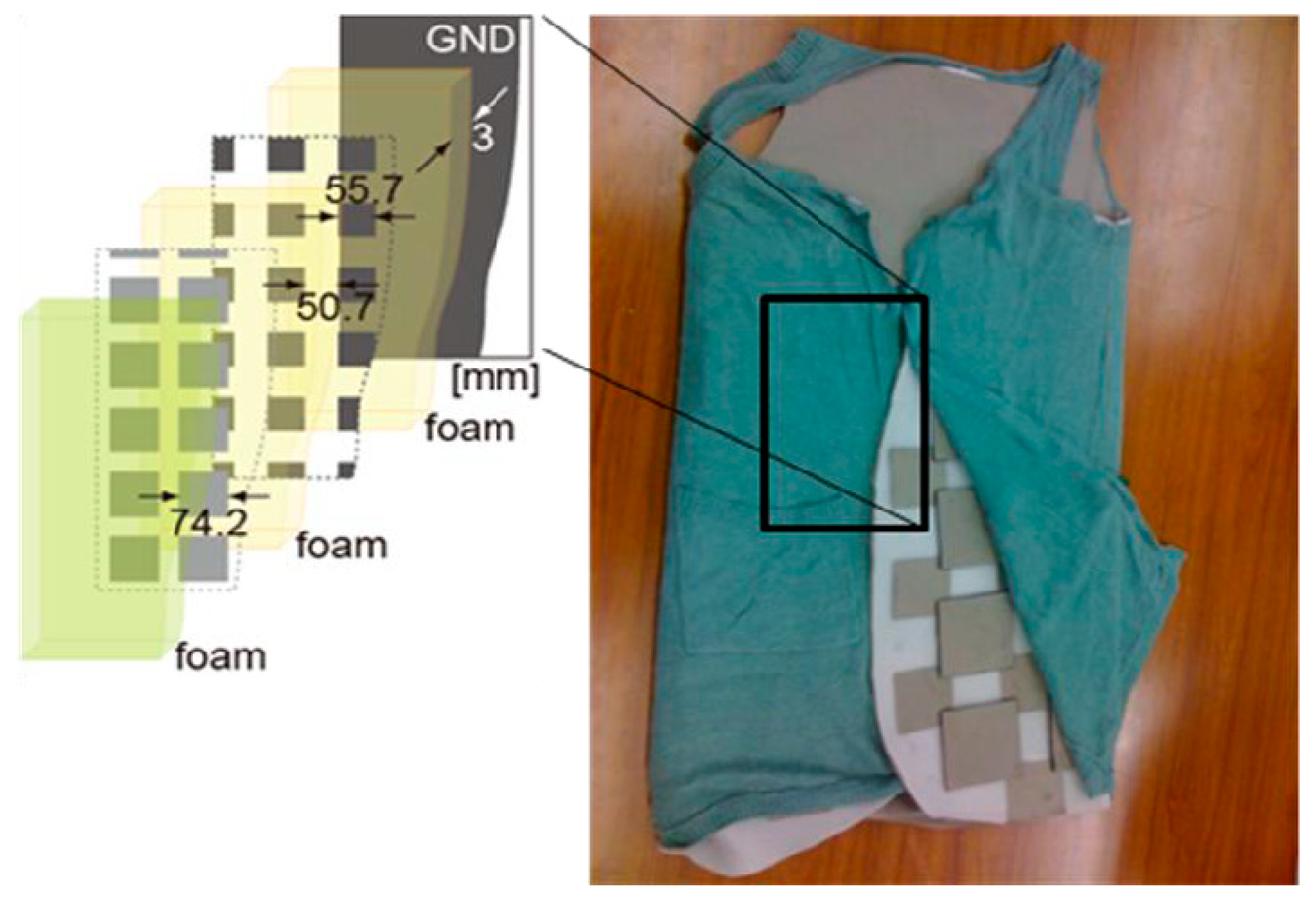Modeling and Analysis of Wearable Antennas
Abstract
:1. Introduction
2. Sheet-Like Transmission Line
2.1. Information Transmission by a Sheet-Like Transmission Line
- the transmission characteristics of only the waveguide provided with the input/output ports 1 and 2 in the lower layer resonator.
- port 1 is connected to the line and the half-wavelength dipole.
- characteristics when the ports 1 and 2 are both half-wavelength dipoles installed on the transmission line.
- the half-wavelength dipole is arranged in the same way as (c).
2.2. Power Transmission by the Sheet-Like Transmission Line
3. Flexible Transmission Line
4. Conclusion and Future Prospects
Author Contributions
Acknowledgments
Conflicts of Interest
References
- Vigneshwaran, C.; Alex, Z.C.; Shambavi, K. Design and analysis of spiral wearable antenna. In Proceedings of the International Conference on Gree Computing Communication and Electrical Engineering (ICGCCEE), Coimbatore, India, 6–8 March 2014; pp. 1–4. [Google Scholar]
- Ali, M.; Gentili, G.B.; Salvadore, C.; Toccafondi, A.; Zani, F. Design and analysis of a wearable antenna system for wireless safety applications. In Proceedings of the European Conference on Antennas and Propagation (EuCAP), Lisbon, Portugal, 13–17 April 2015; pp. 1–4. [Google Scholar]
- Saarika, U.; Sharma, P.K.; Sharma, D. A roadmap to the realization of wireless body area networks: A review. In Proceedings of the International Conference on Electrical, Electronics, and Optimization Techniques (ICEEOT), Chennai, India, 3–5 March 2016; pp. 439–443. [Google Scholar]
- Shankar, S.K.; Tomar, A.S. A survey on wireless body area network and electronic-healthcare. In Proceedings of the 2016 IEEE International Conference on Recent Trends in Electronics, Information & Communication Technology (RTEICT), Bangalore, India, 20–21 May 2016; pp. 598–603. [Google Scholar]
- Movassaghi, S.; Abolhasan, M.; Lipman, J.; Smith, D.; Jamalipour, A. Wireless Body Area Networks: A Survey. IEEE Commun. Surv. Tutor. 2014, 16, 1658–1686. [Google Scholar] [CrossRef]
- Cai, F.; Li, Z.; Agar, J.C.; Wong, C.P.; Papapolymerou, J. Novel stretchable electrically conductive composites for tunable RF devices. In Proceedings of the IEEE/MTT-S International Microwave Symposium Digest, Montreal, QC, Canada, 17–22 June 2012; pp. 1–3. [Google Scholar]
- Liu, Q.; Ford, K.L.; Langley, R.; Robinson, A.; Lacour, S. Flexible dipole and monopole antennas. In Proceedings of the 5th European Conference on Antennas and Propagation (EUCAP), Rome, Italy, 11–15 April 2011; pp. 2052–2056. [Google Scholar]
- Klemm, M.; Kovcs, I.Z.; Pedersen, G.F.; Tröster, G. Novel small-size directional antenna for UWB WBANS/WPAN applications. IEEE Trans. Antennas Propag. 2005, 53, 3884–3896. [Google Scholar] [CrossRef]
- Alomainy, A.; Hao, Y.; Parini, C.G.; Hall, P.S. Comparison between two different antennas for UWB on-body propagation measurements. IEEE Antennas Wirel. Propag. Lett. 2005, 4, 31–34. [Google Scholar] [CrossRef]
- Conway, G.A.; Scanlon, W.G.; Orlenius, C.; Walker, C. In situ measurement of UHF wearable antenna radiation efficiency using a reverberation chamber. IEEE Antennas Wirel. Propag. Lett. 2008, 7, 271–274. [Google Scholar] [CrossRef]
- Klemm, M.; Troester, G. Textile UWB antennas for wireless body area networks. IEEE Trans. Antennas Propag. 2006, 54, 3192–3197. [Google Scholar] [CrossRef]
- Seager, R.; Chauraya, A.; Vardaxoglou, Y.; de Maagt, P. Towards a compact low-frequency woven antenna. In Proceedings of the 2009 IEEE Antennas and Propagation Society International Symposium, Charleston, SC, USA, 1–5 June 2009; pp. 1–4. [Google Scholar]
- Kaivanto, E.; Lilja, J.; Berg, M.; Salonen, E.; Salonen, P. Circularly polarized textile antenna for personal satellite communication. In Proceedings of the 4th European Conference on Antennas and Propagation (EuCAP), Barcelona, Spain, 12–16 April 2010; pp. 1–4. [Google Scholar]
- Lilja, J.; Salonen, P.; Kaija, T.; de Maagt, P. Design and manufacturing of robust textile antennas for harsh environments. IEEE Trans. Antennas Propag. 2012, 60, 4130–4140. [Google Scholar] [CrossRef]
- Kaivanto, E.K.; Berg, M.; Salonen, E.; de Maagt, P. Wearable circularly polarized antenna for personal satellite communication and navigation. IEEE Trans. Antennas Propag. 2011, 59, 4490–4496. [Google Scholar] [CrossRef]
- Salonen, P.; Jashoon, K.; Rahmat-Samii, Y. Dualband E-shaped patch wearable textile antenna. In Proceedings of the 2005 IEEE Antennas and Propagation Symposium, Washington, DC, USA, 3–8 July 2005; pp. 466–469. [Google Scholar]
- Hertleer, C.; Tronquo, A.; Rogier, H.; Vallozzi, L.; van Langenhove, L. Aperture-coupled patch antenna for integration into wearable textile systems. IEEE Antennas Wirel. Propag. Lett. 2007, 6, 392–395. [Google Scholar] [CrossRef]
- Minami, M.; Nishizawa, Y.; Hirasawa, K.; Morikawa, H.; Aoyama, T. MAGIC-Surfaces: Magnetically interfaced surfaces for smart space applications. In Proceedings of the 3rd International Conference on Pervasive Computing (Pervasive2005), Munich, Germany, 8–13 May 2005; pp. 59–64. [Google Scholar]
- Balasubramanian, V.; Stranieri, A. A scalable cloud platform for active healthcare monitoring applications. In Proceedings of the IEEE Conference on e-Learning, e-Management, and e-Services (IC3e), Howthorn, VIC, Australia, 10–12 December 2014; pp. 93–98. [Google Scholar]
- Makino, Y.; Minamizawa, K.; Shinoda, H. Sensor Networking Using Two-Dimensional Electromagnetic Wave. In Proceedings of the Sensor Symposium on Sensors, Micromachines, and Applied Systems, Tokyo, Japan, 20–21 October 2005; pp. 83–88. [Google Scholar]
- Zhou, G.D.; Hua, T. Recent Developments on Wireless Sensor Networks Technology for Bridge Health Monitoring. Math. Probl. Eng. 2013, 2013, 947867. [Google Scholar] [CrossRef]
- Shinoda, H.; Makino, Y.; Yamahira, N.; Itai, H. Surface Sensor Network Using Inductive Signal Transmission Layer. In Proceedings of the Fourth International Conference on Networked Sensing System (INSS07), Braunschweig, Germany, 6–8 June 2007; pp. 201–206. [Google Scholar]
- Sage, G.P.L. 3D Printed Waveguide Slot Array Antennas. IEEE Access 2016, 4, 1258–1265. [Google Scholar] [CrossRef]
- Beer, S.; Rusch, C.; Gulan, H.; Gottel, B.; Girma, M.G.; Hasch, J.; Winkler, W.; Debski, W.; Zwick, T. An Integrated 122-GHz Antenna Array with Wire Bond Compensation for SMT Radar Sensors. IEEE Trans. Antennas Propag. 2013, 61, 5976–5983. [Google Scholar] [CrossRef]
- Torabi, Y.; Dadashzadeh, G. A compact 1:15 unequal Wilkinson power divider using A-CRLH coupled lines. Microw. Opt. Technol. Lett. 2018, 60, 117–122. [Google Scholar] [CrossRef]
- Sung, G.J. Broadband 90° phase shifter using two short stubs. In Proceedings of the IEEE Radio and Wireless Symposium (RWS), New Orleans, LA, USA, 10–14 January 2010; pp. 464–467. [Google Scholar]
- Sodre, A.C.; Costa, I.F.D.; Santos, R.A.D.; Filgueiras, H.R.D.; Spadoti, D.H. Waveguide-Based Antennas Arrays for 5G Networks. Int. J. Antennas Propag. 2018, 2018, 5472045. [Google Scholar] [CrossRef]
- Islam, S.S.; Alam, T.; Faruque, M.R.I.; Islam, M.T. Design and analysis of a complementary split ring resonator (CSRR) metamaterial based antenna for wideband application. Sci. Eng. Compos. Mater. 2015, 24, 573–580. [Google Scholar] [CrossRef]
- Khatri, A.; Punjabi, N.; Dhawangale, A.; Mukherji, S. Inexpensive Polyester Sheet Based Waveguides for Detection of Cardiac Biomarker, Myloperoxidase. Proceedia Eng. 2016, 168, 125–128. [Google Scholar] [CrossRef]
- Pei, Z.; Deng, Z.; Yang, B.; Cheng, X. Application-oriented wireless sensor network communication protocols and hardware platforms: A survey. In Proceedings of the IEEE International Conference on Industrial Technology, Chengdu, China, 21–24 April 2008; pp. 1–6. [Google Scholar]
- Morgan, S.P. Prediction of indoor wireless coverage by leaky coaxial using ray tracing. IEEE Trans. Veh. Technol. 1999, 48, 2005–2014. [Google Scholar] [CrossRef]
- Yamamoto, K.; Nishida, Y.; Sasaki, K.; Muramatsu, D.; Koshiji, F. Electromagnetic Field Analysis of Signal Transmission Line and Electrode Contact Conditions in Human Body Communication. Appl. Sci. 2018, 8, 1539. [Google Scholar] [CrossRef]
- Oh, J.; Park, J.; Lee, H.; Nam, S. The electrode structure to reduce channel loss for human body communication using the human body as a transmission medium. In Proceedings of the IEEE Antenna and Propagation Society (AP-S) International Symposium, Honolulu, HI, USA, 9–15 June 2007. [Google Scholar]
- Tanaka, M.; Jang, J.H. Wearable microstrip antenna for satellite communications. IEICE Trans. Commun. 2004, 87, 2066–2071. [Google Scholar]
- Thiel, D.V.; Galehdar, A. Flexible, light-weight antenna at 2.4 GHz for athlete clothing. In Proceedings of the IEEE Antenna and Propagation Society (AP-S) International Symposium, Honolulu, HI, USA, 9–15 June 2007. [Google Scholar]










| Symbol | Thickness (mm) | Electrical Conductivity at 25 °C (m/Ω·mm2) | Thermal Conductivity at 25 °C W/(m·K) | Mass per Unit Surface (g/m2) | Elastic Modulus (kN/mm2) |
|---|---|---|---|---|---|
| Cu | 0.06 | 6.75 | 49 | 55.87 | 145 |
| ST2050 | 0.06 | 6.73 | 45 | 54.31 | 146 |
| SC8100 | 0.04 | 6.81 | 51 | 52.01 | 142 |
© 2018 by the authors. Licensee MDPI, Basel, Switzerland. This article is an open access article distributed under the terms and conditions of the Creative Commons Attribution (CC BY) license (http://creativecommons.org/licenses/by/4.0/).
Share and Cite
Saraereh, O.A.; Khan, I.; Lee, B.M.; Al-Bayati, A.K.S. Modeling and Analysis of Wearable Antennas. Electronics 2019, 8, 7. https://doi.org/10.3390/electronics8010007
Saraereh OA, Khan I, Lee BM, Al-Bayati AKS. Modeling and Analysis of Wearable Antennas. Electronics. 2019; 8(1):7. https://doi.org/10.3390/electronics8010007
Chicago/Turabian StyleSaraereh, Omar A., Imran Khan, Byung Moo Lee, and A.K.S. Al-Bayati. 2019. "Modeling and Analysis of Wearable Antennas" Electronics 8, no. 1: 7. https://doi.org/10.3390/electronics8010007






